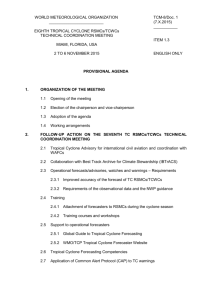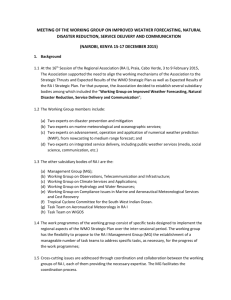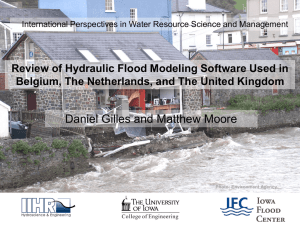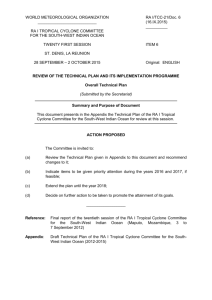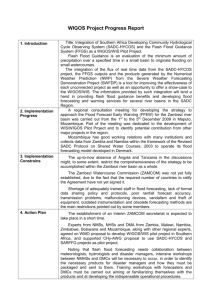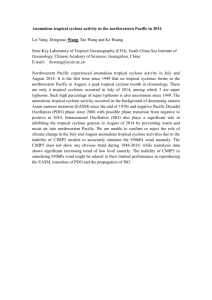English
advertisement
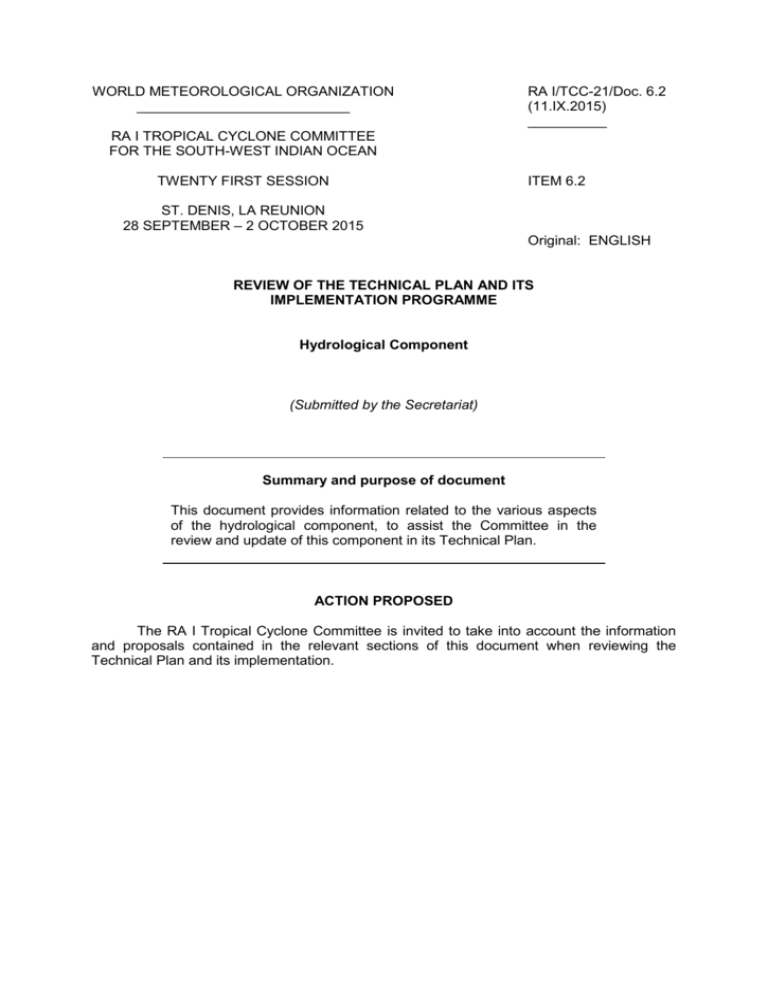
WORLD METEOROLOGICAL ORGANIZATION ___________________________ RA I/TCC-21/Doc. 6.2 (11.IX.2015) __________ RA I TROPICAL CYCLONE COMMITTEE FOR THE SOUTH-WEST INDIAN OCEAN TWENTY FIRST SESSION ITEM 6.2 ST. DENIS, LA REUNION 28 SEPTEMBER – 2 OCTOBER 2015 Original: ENGLISH REVIEW OF THE TECHNICAL PLAN AND ITS IMPLEMENTATION PROGRAMME Hydrological Component (Submitted by the Secretariat) Summary and purpose of document This document provides information related to the various aspects of the hydrological component, to assist the Committee in the review and update of this component in its Technical Plan. ACTION PROPOSED The RA I Tropical Cyclone Committee is invited to take into account the information and proposals contained in the relevant sections of this document when reviewing the Technical Plan and its implementation. RA I/TCC-21/Doc. 6.2, P. 2 WMO HWR contribution to RA I Tropical Cyclone Committee for the South-West Indian Ocean 1. The hydrological contribution to the Technical Plan of the RA I Tropical Cyclone Committee for the South-West Indian Ocean includes activities being carried at country level and sub-regional level with the support of WMO. These consist of: - hydrological networks, services and facilities by NMHSs; - outputs from the SADC-HYCOS Project, the Zambezi Flood Forecasting and Early Warning Project, the Limpopo Flood Forecasting and Warning Project; - Southern Africa Flash Floods Guidance System (SARFFGS); - the Severe Weather Forecasting Demonstration Project (SWFDP); and - the planned integration of SARFFGS and SWFDP. 2. Flooding is one of the main causes of damages and loss of lives associated with tropical cyclones. Improved tropical cyclone forecasting will directly improve flood forecasting and allow more reliable flood warnings. It is therefore important to further deploy efforts for increased cooperation between NMS and NHS experts for better exchange of tropical cyclone forecasts and flood forecasting information. This cooperation stands to benefit from existing networks and data provided my NMHSs. 3. Similarly, outputs from the SADC-HYCOS Project in terms of real time data collection and transmission will augment the effectiveness of the on-going Zambezi Flood Forecasting and Early Warning Project and the Limpopo Flood Forecasting and Warning Project being implemented by WMO in collaboration with USAID and the riparian countries. 4. WMO, jointly with the Hydrologic Research Centre in San Diego (HRC), the USA National Oceanic and Atmospheric Administration (NOAA) and USAID is also implementing the Southern Africa Region Flash Flood Guidance System (SARFFGS) currently covering nine countries (Botswana, Lesotho, Malawi, Mozambique, Namibia, South Africa, Swaziland, Zambia, Zimbabwe) in basins that are affected by the tropical cyclones in the South-West Indian ocean. This system uses satellite based Hydro-estimator rainfall estimation to predict the occurrence and extent of flash floods. 5. The SWFDP applies a regional-based model and system to provide forecasters at the various Southern Africa NMHSs the necessary data and information for provision of timely and effective warnings of severe weather conditions, including, strong winds, heavy rains, hazardous waves and thunderstorms that could lead to flash floods or localized flooding. The SWFDP for Southern Africa encompasses 16 countries, namely, Angola, Botswana, Comoros, Democratic Republic of Congo, Lesotho, Madagascar, Malawi, Mauritius, Mozambique, Namibia, Seychelles, South Africa, Swaziland, Tanzania, Zambia and Zimbabwe. 6. WMO is also in the process of implementing a project to integrate the SWFDP and SARFFGS programmes to improve forecasting of severe hydrometeorological events by NMHSs; enhance user interfaces and expand the suite of products available to forecasters using the systems; and strengthen the capacity NMHSs to provide timely and effective early warnings of extreme hydrometeorological events with appropriate lead times for taking appropriate and effective response actions. ______________
